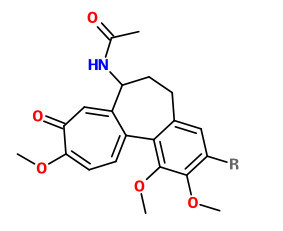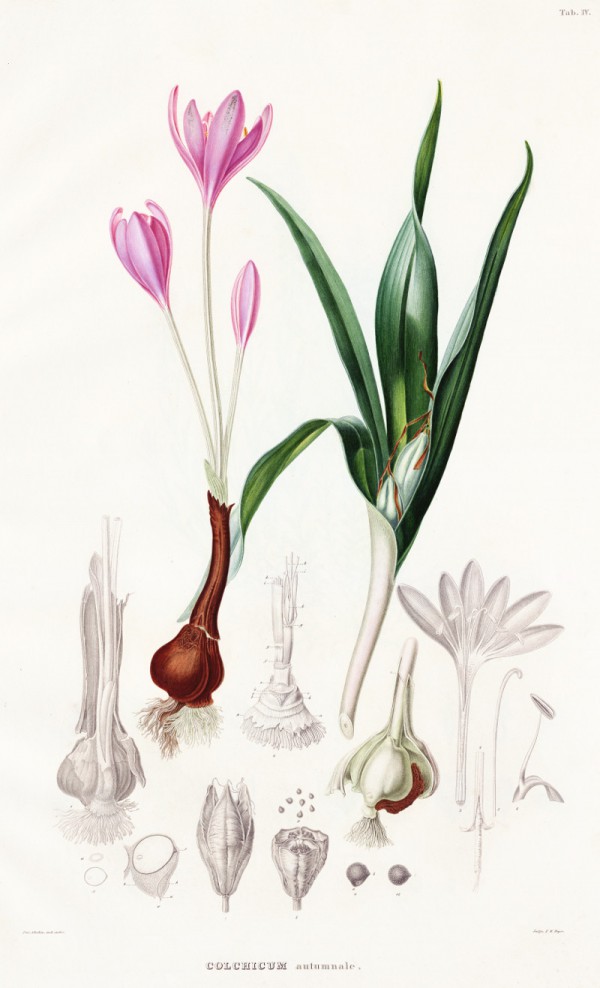Benutzer-Werkzeuge
Colchicum autumnale L. - Liliaceae - autumn crocus, meadow saffron, Herbstzeitlose
Perennial herb, up to 40cm tall (leaves), native to Europe; leaves broad lanceolate, appearing in spring with fruits (capsules); flower a narrow erect tube, pinkish to pale purple, appearing in autumn (crocus-like, but with 6 - not 3 - stamens and 3 simple stigmas).
The extraction of C.autumnale seeds by supercritical carbon dioxide gave the alkaloids (mean total content 1.88%) colchicine (1.25%), 3-demethylcolchicine (0.17%) and colchicoside (0.45%). Solvent extraction (methanol/water 95:5) gave total alkaloids 1.87%, colchicine (1.20%), 3-demethylcolchicine (0.12%) and colchicoside (0.54%).
[Supercritical carbon dioxide extraction of colchicine and related alkaloids from seeds of Colchicum autumnale L., Ellington, E., Bastida, J., Viladomat, F., Codina, C., Phytochemical Analysis, 14(3), 2003, 164-169]
 colchicine (R=OMe), 3-demethylcolchicine (R=OH) and colchicoside (R=O-β-D-Gluc)
colchicine (R=OMe), 3-demethylcolchicine (R=OH) and colchicoside (R=O-β-D-Gluc)
Extracted alkaloids (corms, Colchici tuber and seeds, Colchici semen) are used „in carefully measured dosages to treat acute attacks of gout. It is also used for the therapeutic treatment of familial Mediterranean fever.“
[Medicinal Plants of the World. Ben-Erik Van Wyk and Michael Wink, Pretoria 2004, 110]
„Colchicine is primarily metabolized by the liver, undergoes significant enterohepatic re-circulation, and is also excreted by the kidneys… The usual adult oral doses for FMF is 1.2–2.4 mg/day; in acute gout 1.2 mg/day and for gout prophylaxis 0.5–0.6 mg/day three to four times a week. High fatality rate was reported after acute ingestions exceeding 0.5 mg/kg. The lowest reported lethal doses of oral colchicine are 7–26 mg… Colchicine's toxicity is an extension of its mechanism of action - binding to tubulin and disrupting the microtubular network. As a result, affected cells experience impaired protein assembly, decreased endocytosis and exocytosis, altered cell morphology, decreased cellular motility, arrest of mitosis, and interrupted cardiac myocyte conduction and contractility. The culmination of these mechanisms leads to multi-organ dysfunction and failure.“
[Colchicine poisoning: the dark side of an ancient drug., Finkelstein, Y., Aks, S.E., Hutson, J.R., Juurlink, D.N., Nguyen, P., Dubnov-Raz, G., Bentur, Y., Clinical toxicology, 48(5), 2010, 407-414]
The range of alkaloid contents [% of dry mass] in different parts of C.autumnale is
described as (corms, leaves, flowers, seeds): colchicine (0.2-1.9, 0.02-1.4, 0.15-0.85, 0.14-1.2); demecolcine (0.18-0.37, 0.08, n.s., n.s.), colchicoside (n.s., 0, 0, 0.1-0.48).
[Colchicum autumnale L., Jung, L.S., Winter, S., Eckstein, R.L., Kriechbaum, M., Karrer, G., Welk, E., Otte, A., Perspectives in Plant Ecology, Evolution and Systematics, 13(3), 2011, 227-244]

Meyer,G.F.W., Flora des Königreichs Hannover, vol.1 t.4 (1842) [W.Eberlein]
http://plantgenera.org/species.php?id_species=263092
Colchicum autumnale
© Rolf Marschner (2016),
www.botanische-spaziergaenge.at
